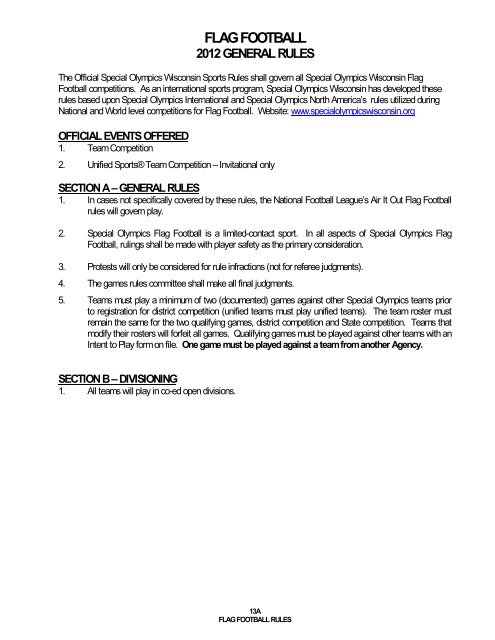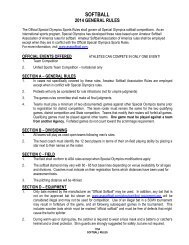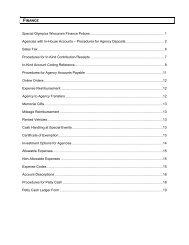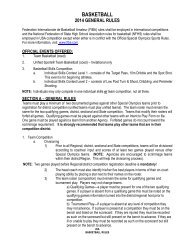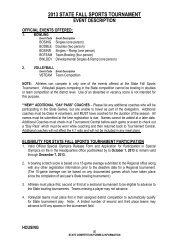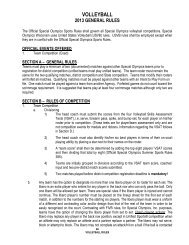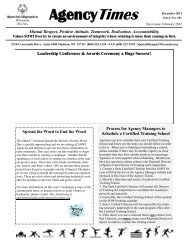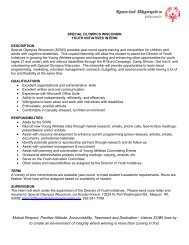FLAG FOOTBALL - Special Olympics Wisconsin
FLAG FOOTBALL - Special Olympics Wisconsin
FLAG FOOTBALL - Special Olympics Wisconsin
Create successful ePaper yourself
Turn your PDF publications into a flip-book with our unique Google optimized e-Paper software.
<strong>FLAG</strong> <strong>FOOTBALL</strong><br />
2012 GENERAL RULES<br />
The Official <strong>Special</strong> <strong>Olympics</strong> <strong>Wisconsin</strong> Sports Rules shall govern all <strong>Special</strong> <strong>Olympics</strong> <strong>Wisconsin</strong> Flag<br />
Football competitions. As an international sports program, <strong>Special</strong> <strong>Olympics</strong> <strong>Wisconsin</strong> has developed these<br />
rules based upon <strong>Special</strong> <strong>Olympics</strong> International and <strong>Special</strong> <strong>Olympics</strong> North America’s rules utilized during<br />
National and World level competitions for Flag Football. Website: www.specialolympicswisconsin.org<br />
OFFICIAL EVENTS OFFERED<br />
1. Team Competition<br />
2. Unified Sports® Team Competition – Invitational only<br />
SECTION A – GENERAL RULES<br />
1. In cases not specifically covered by these rules, the National Football League’s Air It Out Flag Football<br />
rules will govern play.<br />
2. <strong>Special</strong> <strong>Olympics</strong> Flag Football is a limited-contact sport. In all aspects of <strong>Special</strong> <strong>Olympics</strong> Flag<br />
Football, rulings shall be made with player safety as the primary consideration.<br />
3. Protests will only be considered for rule infractions (not for referee judgments).<br />
4. The games rules committee shall make all final judgments.<br />
5. Teams must play a minimum of two (documented) games against other <strong>Special</strong> <strong>Olympics</strong> teams prior<br />
to registration for district competition (unified teams must play unified teams). The team roster must<br />
remain the same for the two qualifying games, district competition and State competition. Teams that<br />
modify their rosters will forfeit all games. Qualifying games must be played against other teams with an<br />
Intent to Play form on file. One game must be played against a team from another Agency.<br />
SECTION B – DIVISIONING<br />
1. All teams will play in co-ed open divisions.<br />
13A<br />
<strong>FLAG</strong> <strong>FOOTBALL</strong> RULES
SECTION C - FIELD<br />
The playing field measures 60 yards long (including the end zones) and 25 yards wide. A space of at least 10<br />
yards around the field must be free and clear of obstructions. The field can be marked with paint of a visible<br />
color, and pylons/cones.<br />
SECTION D – EQUIPMENT<br />
1. An intermediate (youth) size football will be used in all divisions. Leather, synthetic leather, or rubber<br />
footballs are appropriate for use in training and competition. The ball should be properly inflated and<br />
inspected periodically for defects or damage. Nerf footballs may be used in training to assist athletes<br />
who are having difficulty catching the ball, but will not be used in competition.<br />
2. All players must wear a protective mouthpiece during training and competition.<br />
3. Steel spikes, street shoes and jewelry are not allowed. Gym, tennis, running or rubber spike shoes will<br />
be allowed.<br />
4. A one-piece, three-flag belt is the required flag belt for competition.<br />
5. Players with illegal uniforms will not be allowed to play. Players with non-matching uniforms will be<br />
penalized accordingly. Legality of a uniform may be determined by the referee or by the event<br />
coordinator. Proper uniforms and uniform numbering will be enforced! Individuals who do not adhere<br />
to uniform regulations will not be allowed to enter a game. All players on a team must wear uniforms<br />
(shirt and pants) that are identical in color, trim, style and material. An Arabic number of contrasting<br />
color at least six inches high must be worn on the back of all uniform shirts. Taped numbers on pinnies<br />
are not legal in SOWI competition. All uniform shirts must be tucked in at the waist. All players' pants<br />
shall be either all long or all short in style and may not have pockets. If this must vary due to health or<br />
religious reasons, a <strong>Special</strong> Needs form must be completed upon registration. No cut-off shorts or<br />
denim jeans are allowed. Hats (baseball style caps or caps with hard visor) may not be worn.<br />
Receiver’s gloves may be worn. Athletes wearing improper uniforms will not be allowed to participate.<br />
No jewelry is allowed.<br />
6. Flag belts (as described in equipment section) must be worn by all players at all times as part of the<br />
uniform. In addition, any player that intentionally wears their flag belt improperly (tied) while in play will<br />
be penalized.<br />
14A<br />
<strong>FLAG</strong> <strong>FOOTBALL</strong> RULES
SECTION E – OFFICIALS AND THEIR DUTIES<br />
1. Officials will conduct the games in accordance to specified rules.<br />
2. Local, regional, district and State competitions should utilize WIAA certified officials when possible.<br />
3. Officials shall have full authority to interpret rules. For further questions, the tournament rules<br />
committee shall be consulted.<br />
4. Officials shall have the power to make all decisions on any points not specifically covered in the rules.<br />
5. In case of injury, equipment repair, or unsafe playing conditions, the official shall stop play but time<br />
does not stop for any reason unless the official considers it to be excessive. The decision to stop time<br />
is at the official’s discretion. Time will be stopped for time outs.<br />
6. The official may call a game completed (for darkness or weather) at any time.<br />
7. The official is also responsible for the following:<br />
a. Having a presence at every play.<br />
b. Indicating if a play is starting in a No-Run Zone.<br />
c. Designating the Neutral Zone and Line of Scrimmage.<br />
i. A special marker, placed by the official, will mark the beginning of the Neutral Zone<br />
(Rush Line).<br />
ii. A special marker, placed by the official, will mark the Line of Scrimmage.<br />
8. Following each team’s score, the official shall pull the flag belt off of the scoring athlete to verify that the<br />
flag belt was attached properly.<br />
SECTION F – PLAYERS AND SUBSTITUTES<br />
1. Each team will consist of a minimum of 5 and maximum of 15 players on the roster in order to be<br />
eligible to be registered for competition.<br />
2. Teams shall field 5 players to start the game (required). Teams may continue with a minimum of 4<br />
players, if necessary, due to disqualification or injury.<br />
3. Substitutions may be made anytime the ball is dead.<br />
4. Once a player has entered the field of play as a substitution, they must remain in the game for at least<br />
one play before being replaced.<br />
SECTION G – THE GAME<br />
1. A regulation game shall consist of two 20-minute halves (running time), with a 5-minute halftime.<br />
2. Each team receives one 60-second time-out per half. An unused time-out in the first half does not<br />
carry over to the second half. The clock will stop for time outs.<br />
3. All line-up cards must be presented to the official scorekeeper 10 minutes before the start of any game.<br />
4. The first possession shall be decided by a coin toss at the beginning of the game. The winner of the<br />
coin toss will choose offense, defense or end of field to defend. The team winning the coin toss may<br />
defer its choice to the second half.<br />
5. A stopped-clock format will be used during the last two minutes of each half of the game.<br />
15A<br />
<strong>FLAG</strong> <strong>FOOTBALL</strong> RULES
SCORING<br />
1. Touchdown: 6 points<br />
2. Extra Point: 1 point from the 5 yard line<br />
2 points from the 10 yard line<br />
3. Safety: 2 points<br />
POSSESSIONS<br />
1. All possessions, except following an interception, start at the offensive team’s 5-yard line.<br />
2. The offense has 4 plays to cross mid-field.<br />
3. Once the offense crosses mid-field, they have 4 additional plays to score a touchdown.<br />
4. If the offensive team fails to cross mid-field or score a touchdown in the designated number of<br />
plays, possession of the ball changes and the opposite team starts at their 5-yard line.<br />
5. Interceptions change possession of the ball at the spot of the interception. A ball intercepted in<br />
the end zone is spotted at the 5-yard line.<br />
6. Each time the ball is spotted (marked ready for play by the official) the team has 30 seconds to<br />
snap the ball.<br />
7. The ball is marked at the spot where the position of the ball is when the player is declared<br />
down (carrier’s flag belt is removed or hand/knee touches ground).<br />
POSITIONS/SNAP<br />
1. The ball must be snapped between the legs to start each play.<br />
2. No minimum number of defensive players is required to line up on the line of scrimmage.<br />
RUSHING THE QB<br />
1. All players that rush the quarterback when the ball is snapped must start from behind the Rush<br />
Line.<br />
2. Players not rushing the quarterback may defend the line of scrimmage.<br />
3. Once the quarterback hands off the ball, the neutral zone no longer exists, and all defenders<br />
are eligible to rush.<br />
RUNNING<br />
1. The Quarterback (player receiving the snap) CANNOT run the ball.<br />
2. Only direct hand-offs behind the line of scrimmage are legal. Laterals or pitches of any kind<br />
are not allowed.<br />
3. The player who takes a hand-off can pass the ball, as long as he/she does not pass the line of<br />
scrimmage.<br />
16A<br />
<strong>FLAG</strong> <strong>FOOTBALL</strong> RULES
4. Any ball snapped from the offensive No-Run Zone must be passed. The purpose is to avoid<br />
short yardage power running situations. Exception to this rule is made for the following<br />
instance: Once the Offense crosses the mid-field line, the mid-field No-Run Zone is no longer<br />
enforced (such as when an Offensive foul moves the ball back beyond the mid-field line).<br />
5. The ball carrier may not dive, hurdle or commit acts of flag guarding to shield a defender from<br />
grasping his/her flag.<br />
6. The ball is marked at the spot where the position of the ball is when the player is declared<br />
down (carrier’s flag belt is removed or hand/knee touches ground).<br />
PASSING AND RECEIVING<br />
1. All passes must be forward and received beyond the line of scrimmage.<br />
2. All players are eligible to receive a pass, including the quarterback if he/she has legally handed<br />
the ball off.<br />
3. Only one player is allowed in motion at the snap and he/she may not be moving toward the line<br />
of scrimmage at the snap.<br />
4. A player must have at least one foot in bounds when making a catch.<br />
5. Interceptions change possession of the ball at the point of the interception. A ball intercepted<br />
in the end zone is spotted at the 5 yard line.<br />
DEAD BALL/FUMBLES<br />
1. There are no fumbles (and no change of possession on a fumble). The ball is called “dead”<br />
and spotted where it hits the ground. If the ball is fumbled forward, it will be spotted where it<br />
left the player’s possession. The team with possession of the ball retains possession on all<br />
fumbles.<br />
2. Play is ruled dead when:<br />
The ball carrier’s flag is pulled<br />
The ball carrier loses his/her flag belt<br />
The ball carrier steps out of bounds<br />
The ball carrier’s knee or hand touches the ground<br />
A touchdown, extra point, or safety is scored<br />
When the defense obtains possession of the ball<br />
When a forward pass strikes the ground or is caught simultaneously by opposing<br />
players (the offense retains possession)<br />
A pass is intercepted (no returns)<br />
A receiver catches a ball without his/her flags attached<br />
A snapped ball touches the ground<br />
Any inadvertent whistle.<br />
17A<br />
<strong>FLAG</strong> <strong>FOOTBALL</strong> RULES
PENALTIES<br />
1. Neither team shall commit any act which, in the opinion of the referee, tends to make a<br />
travesty of the game. This includes intentionally committing fouls to gain an advantage and<br />
repeatedly committing fouls which halve the distance to the goal line.<br />
2. All penalties are assessed from the line of scrimmage.<br />
3. No penalty may take the ball more than half the distance to the offender’s goal line.<br />
4. All penalties are automatically accepted (no option to decline). Exception to this rule is made<br />
in the case where the acceptance of the penalty would result in the change of possession,<br />
score, or cause an advantage to the offending team.<br />
5. Sportsmanship/Roughing: The officials will disqualify any player who participates in rough or<br />
unsportsmanlike play. No warning is required.<br />
6. Offense: 10 yards from the line of scrimmage and loss of down<br />
Illegal motion (more than 1 player moving at snap, moving forward at snap)<br />
Offside (in neutral zone at snap, false start)<br />
Illegal forward pass (not received beyond line of scrimmage)<br />
Pass Interference (picking or pushing defender)<br />
Illegal contact (holding, blocking, bumping)<br />
Flag Guarding<br />
Delay of Game (failing to snap within 30 seconds of ball placement)<br />
Diving to advance the ball or gain an advantage<br />
Quarterback running the ball from the snap<br />
Running the ball in No-Run Zones<br />
Too many players on the field<br />
7. Defense: 10 yards from line of scrimmage and automatic first down<br />
Offside (in or beyond neutral zone at snap)<br />
Pass Interference (any contact with the intended receiver while the pass is in the air)<br />
Illegal contact (holding, blocking, bumping)<br />
Illegal flag pull (before receiver has ball)<br />
Illegal rushing<br />
Too many players on the field<br />
Exceptions to this penalty:<br />
o In the case where there is a Defensive foul and an unsuccessful extra point<br />
attempt in the same play, the unsuccessful attempt is negated and the<br />
offensive team is given the option to start the play over at either:<br />
• Half the distance to the goal<br />
• The original Line of Scrimmage<br />
o In the case where there is a Defensive foul and a successful extra point<br />
attempt, the Official shall decline (or wave off) the penalty and all eligible<br />
points are awarded.<br />
All penalties will be called and enforced at the discretion of the officials on the field and can not be<br />
protested.<br />
18A<br />
<strong>FLAG</strong> <strong>FOOTBALL</strong> RULES
OVERTIME<br />
1. A coin toss is held to determine first possession.<br />
2. Each team receives two (2) plays starting from midfield and the team gaining the most points<br />
or gaining the most yardage if neither scores is awarded one (1) extra point and wins the<br />
game.<br />
3. Exceptions to this rule are as follows:<br />
a) If the team with the first attempt in overtime scores on the first play, the opposing team<br />
must score on its first play also.<br />
b) If both teams score a touchdown, or gain the same yardage, the procedure is repeated<br />
until one (1) team wins.<br />
c) Interception: The team that intercepts the pass automatically wins the game.<br />
Reason: A loss of possession is the worst outcome a team can have. The<br />
intercepting team would only have to take a knee in order to have a better<br />
outcome with a yardage advantage. They will not be required to take the field.<br />
SECTION H – SUPPLEMENT TO THE RULES<br />
1. Boundary Lines: The outer perimeter lines around the field. They include the sidelines and the rear end<br />
zone lines. Stepping on the boundary line is considered out of bounds.<br />
2. Charging: The movement of the ball carrier directly at a defensive player who has established<br />
position on the field. This includes lowering the head, making contact with the<br />
defender with a shoulder, chest or forearm.<br />
3. Dead Ball: The period of time immediately before or after a play.<br />
4. Defense: the team opposing the offense to prevent them from advancing the ball.<br />
5. Delay of the Game: The ball must be put in play promptly and legally and any action or lack of action by<br />
either team that tends to prevent this is considered a delay of the game. This includes:<br />
Interrupting the 30-second count for any reason except for a granted time-out.<br />
Consuming more than 30 seconds to snap the ball after it is ready for play.<br />
Failing to remove an injured player for whose benefit an excess time-out has<br />
been granted.<br />
Deliberately advancing the ball after it has been declared dead.<br />
6. Diving: A defensive or offensive player may dive to catch a pass, however, diving is illegal<br />
when used to down a player or advance a ball. A player cannot dive in an attempt to<br />
gain extra yardage. The team will be penalized accordingly.<br />
7. Downs (1-2-3-4): The offensive team has four attempts or “Downs” to advance the ball. They must<br />
cross the Line to Gain to get another set of downs or to score.<br />
8. Eligible Receiver: All offensive players are eligible to receive a pass.<br />
19A<br />
<strong>FLAG</strong> <strong>FOOTBALL</strong> RULES
9. False Start: No member of the offensive team may simulate the start of the play before the ball is<br />
snapped.<br />
10. Flag Guarding (Shielding): An act by the ball carrier to prevent a defender from pulling the ball<br />
carrier’s flags. This includes:<br />
Swinging the hand or arm over the flag belt<br />
Placing the ball in possession over the flag belt<br />
Lowering the elbow or head<br />
Lowering the shoulders or arm over the flag belt<br />
Stiff arming the defense<br />
Spinning<br />
11. Fumble Any time an offensive player loses possession of the ball.<br />
12. Hand-offs: Handing the ball off is transferring player possession from one teammate to<br />
another without throwing or kicking it. All hand-offs must be to the side of, or behind<br />
the player with possession and must take place behind the line of scrimmage.<br />
13. Hurdling: Jumping over or attempting to jump over a player, by the ball carrier, to prevent from<br />
being downed or to gain additional yardage is illegal. (Note: Jumping over a player<br />
who is on the ground to avoid injury, by official’s judgment, is legal.)<br />
14. Illegal Rush: A. The Rusher leaves the Rush Line before the snap and crosses the Line of<br />
Scrimmage before a handoff.<br />
B. Any defensive player not lined up at the Rush Line crosses the Line of Scrimmage<br />
before the ball is handed off.<br />
15. Inadvertent Whistle: An Official’s whistle that is performed in error. In case of an inadvertent<br />
whistle the team in possession of the ball may choose to accept the result of<br />
the play at the point where the play was blown dead or choose to replay the<br />
down.<br />
16. Lateral: A backwards or sideways toss of the ball by the ball carrier. (Illegal)<br />
17. Line of Scrimmage: A vertical plane through the point of the ball nearest the defensive team’s goal<br />
line. Each player on a team must be on its side of the line of scrimmage when<br />
the ball is snapped.<br />
18. Line-To-Gain: The line the offense must pass to get a first down or score.<br />
19. Live Ball: The period of time that the play is in action. The ball is live at the snap of the ball and<br />
remains live until the official whistles the ball dead.<br />
20. Motion: Only one player of the offensive team may be in motion at the snap. This player must<br />
be behind the quarterback and not moving toward its goal line at the time the ball is<br />
snapped. If the player comes to a stop he/she must be set for one second.<br />
21. Neutral Zone: Applied to the Defensive team, it is a 5 yard imaginary zone between the Line of<br />
Scrimmage and the Rush Line. All players that rush the quarterback on the snap must<br />
be a minimum of 5 yards from the line of scrimmage.<br />
20A<br />
<strong>FLAG</strong> <strong>FOOTBALL</strong> RULES
22. No-Run Zone: Applied only to the Offensive direction of play, it is a 5 yard imaginary zone before the<br />
mid-field line and goal line. Any ball snapped from these zones must be passed. The<br />
purpose is to avoid short yardage power running situations. Exception to this rule is<br />
made for the following instance: Once the Offense crosses the mid-field line, the midfield<br />
No-Run Zone is no longer enforced (such as when an Offensive foul moves the<br />
ball back beyond the mid-field line).<br />
23. Offense: The team with possession of the ball.<br />
24. Pass Interference Any contact with the intended receiver while the pass is in the air.<br />
25. Passer: The offensive player that throws the ball and may or may not be the Quarterback.<br />
26. Rush Line: The rush line is a vertical plane 5 yards into the defensive side from the Line of<br />
Scrimmage.<br />
27. Rusher: The defensive player(s) assigned to rush the Quarterback to prevent him/her from<br />
passing by pulling his/her flags or blocking the pass.<br />
28. Screen Blocking:<br />
Legally obstructing an opponent without contacting him/her with any part of<br />
the screen blocker’s body.<br />
The screen blocker shall have his/her arms fully extended to the ground (below the<br />
waist) either at his/her side, in front, or behind his/her back. He/she may also cross<br />
the arms across the chest.<br />
Any use of arms, elbows, or legs to initiate contact during the screen block is<br />
illegal.<br />
A player must be on his/her feet before, during and after screen blocking.<br />
Screen blocking is the only form of legal blocking that can be used by any player<br />
at any time.<br />
If any of the provisions listed below are violated, and contact results, the screener<br />
has committed an illegal block.<br />
o The screen blocker must give an opponent at least one step if opponent has<br />
his/her back to blocker.<br />
o The screen blocker must not initiate contact with opponent.<br />
o The screen blocker may not take a position so close to a moving opponent<br />
that this opponent cannot avoid contact by stopping or changing directions.<br />
o Immediately after the snap of the ball, a blocker may move laterally or<br />
backward two (2) steps.<br />
o No moving screens are allowed downfield.<br />
o The ball carrier may not be escorted downfield by another Offensive player.<br />
29. Shift: A shift is the action of one or more offensive players who after taking set positions<br />
move to a new position prior to the snap. A player who shifts must reset for one<br />
second prior to the snap.<br />
30. Shuffle Pass: A legal pass attempted behind the line of scrimmage. The throwing motion must<br />
initiate above the waist.<br />
21A<br />
<strong>FLAG</strong> <strong>FOOTBALL</strong> RULES
31. Snap: A snap is the legal act of passing the ball through the legs from the ground to the<br />
quarterback to start a play. Play starts at the initial movement of the ball.<br />
32. Substitution: Any player on the roster may enter upon the completion of a play (when the ball is<br />
dead). Each substitute must play at least one down prior to being replaced. A replaced<br />
player must leave the field immediately.<br />
33. Unsportsmanlike Conduct: Rude, confrontational or offensive behavior or language.<br />
34. Stopped Clock Format: During the last 2 minutes of each half, the clock will stop for the following:<br />
Incomplete pass – Restart on the snap<br />
Out-of-bounds – Restart on the snap<br />
Safety – Restart on the snap<br />
Team time out – Restart on the snap<br />
Penalty – Restart on the snap<br />
Official’s time out – Restart at Official’s discretion<br />
Team attempting to conserve time illegally – Restart on the ready<br />
Team attempting to consume time illegally – Restart on the snap<br />
Inadvertent whistle – Restart on the ready<br />
Change of possession – Restart on the snap<br />
22A<br />
<strong>FLAG</strong> <strong>FOOTBALL</strong> RULES
Flag Football Individual Skills Assessment Test<br />
Catching: “Run & Catch”<br />
1. Purpose: To measure athlete’s ability to catch a football.<br />
2. Equipment: 5 footballs, measuring tape, field paint, 28 cones, or numbered mats to mark catching<br />
spots and start/finish lines.<br />
3. Description: A starting line, finish line, quarterback box, and 5 catching spots should be marked/<br />
placed on the field. The catching spots should be marked 1-5 (left to right).<br />
- The quarterback box should be placed in between the starting and finish line.<br />
- The quarterback box will be 4 yards X 4 yards.<br />
- Catching spots are 1 yard X 1 yard.<br />
- Catching Boxes 1 & 5 will be 5 yards from the quarterback box.<br />
- Catching Boxes 2 & 4 will be 12 yards from the quarterback box.<br />
- Catching Box 3 will be 20 yards from the quarterback box.<br />
- The starting line should be placed on the left side of the quarterback and the finish line should<br />
be placed on the right side of the quarterback. Athletes will start to the left of the quarterback<br />
and finish on the right side of the quarterback.<br />
- Each athlete will begin at the starting line. Once the official quarterback gives the signal, the<br />
athlete must run to each catching box (in numerical order), stopping to catch a pass at each<br />
spot. Once the ball is completely caught, the athlete drops the ball and goes to the next<br />
catching box. Once the last ball is caught, the athlete will sprint through the finish line. If a<br />
throw from the QB is deemed inaccurate, athletes will receive an additional throw from the<br />
same spot.<br />
4. Scoring: Athletes will receive points for completing catches.<br />
- 2 pts: for a complete catch (clearly caught with both hands)<br />
- 0 pts: if athlete is unable to catch or touch a well-thrown pass.<br />
- Athletes can gain a maximum of 10 points in this drill.<br />
- Officials will be present to confirm point total.<br />
23A<br />
<strong>FLAG</strong> <strong>FOOTBALL</strong> RULES
Throwing for Accuracy<br />
1. Purpose: To measure the athlete’s ability to throw a football accurately.<br />
2. Equipment: 5 footballs, measuring tape, field paint, 28 cones, or numbered mats to mark catching<br />
spots and start/finish lines.<br />
3. Description: A starting line, finish line, quarterback box, and 5 catching boxes should be marked/<br />
placed on the field. The catching boxes should be marked 1-5 (left to right).<br />
- The quarterback box should be placed in between the starting and finish line.<br />
- The quarterback box should be placed in between the starting and finish line.<br />
- The quarterback box will be 4 yards X 4 yards.<br />
- Catching spots are 1 yard X 1 yard.<br />
- Catching Boxes 1 & 5 will be 5 yard from the quarterback box.<br />
- Catching Boxes 2 & 4 will be 12 yards from the quarterback box.<br />
- Catching Box 3 will be 20 yards from the quarterback box.<br />
- The starting line should be placed on the left side of the quarterback and the finish line should<br />
be placed on the right side of the quarterback.<br />
- The player being tested stands inside of the quarterback box. Five human targets/volunteers<br />
are placed in each catching spot. The athlete must throw to each target (in numerical order),<br />
gaining points for completed passes. The receiver must stay in the catching box. Scoring is<br />
based on accuracy of the throw not on the volunteer catching the pass.<br />
4. Scoring: Athletes will receive points for completed passes.<br />
- 2 pts: For an accurate & completed throw.<br />
- 0 pts: Receiver is unable to catch or touch ball in targeted area. If the ball hits the ground prior<br />
to reaching the target, the throw will be recorded as a failed attempt.<br />
- Athletes can gain a maximum of 10 points in this drill.<br />
24A<br />
<strong>FLAG</strong> <strong>FOOTBALL</strong> RULES
Throwing for Distance<br />
1. Purpose: To measure the athlete’s ability to throw a football for distance.<br />
2. Equipment: 3-5 footballs; measuring tape; field paint; 4 cones<br />
3. Description: Athlete gets two attempts to throw football as far as possible. The goal line of a <strong>Special</strong><br />
<strong>Olympics</strong> flag football field can be used as the starting line.<br />
4. Scoring: Athletes will receive a maximum of 5 points per throw.<br />
- 1 pt: 0-10 yards<br />
- 2 pt: 10-20 yards<br />
- 3 pt: 20-30 yards<br />
- 4 pts: 30-40 yards<br />
- 5 pts: 40+ yards<br />
- Athletes can gain a maximum of 10 points in this drill.<br />
25A<br />
<strong>FLAG</strong> <strong>FOOTBALL</strong> RULES
Agility & Speed: Hand-Off<br />
1. Purpose: To measure the athlete’s speed, agility and ability to receive a hand-off.<br />
2. Equipment: 3 footballs, 8 cones, field paint, measuring tape, and stop watch<br />
3. Description: The ball is marked at the 20 yard line or 20 yards from the goal line. The quarterback will<br />
be position 20 yards from the goal line. Athlete begins 5 yards behind the quarterback and between the<br />
cones.<br />
- The quarterback will give the signal and hand the ball off to the athlete.<br />
- The clock will start on the quarterbacks signal.<br />
- The athlete must maneuver around the four cones and sprints to the finish line/end-zone<br />
between the cones and must maintain possession of the football.<br />
- Each cone will be 1.25 yards apart<br />
- A fumble at the exchange between the QB and the athlete would be a redo.<br />
- If an athlete losses control of the ball, the clock continues to run. The athlete can recover the ball.<br />
However, if the ball goes outside the 3m lane, the athlete can either pick up the nearest back-up<br />
football or recover the errant football to continue the event.<br />
4. Scoring: The athlete will receive two attempts. The athlete can receive a max of 5 points per attempt<br />
for a total of 10 points.<br />
- The athlete will be timed from QB’s signal to when he/she crosses the finish line<br />
between the cones with possession of the football.<br />
- One-second will be added for every missed cone.<br />
- Conversion Chart will indicate score. Athlete can gain a maximum of 10 points.<br />
Agility & Speed: Hand-Off<br />
Conversion Chart<br />
Seconds Points<br />
Under 7.5 seconds 5<br />
7.5-9 4<br />
9.1-10.5 3<br />
10.5-12.0 2<br />
12.1 and over 1<br />
26A<br />
<strong>FLAG</strong> <strong>FOOTBALL</strong> RULES
Flag Pulling<br />
1. Purpose: To measure the athlete’s ability to pull an opponent’s flag.<br />
2. Equipment: 5 footballs, 4 cones, 5 volunteers and measuring tape<br />
3. Description: The athlete stands in the middle of a 5 X 5 yard grid.<br />
- Volunteers will one at a time jog through the grid with a football and attached flags. The athlete<br />
attempts to pull the volunteers flag before the volunteer leaves the grid. Volunteers will move<br />
straight through the box without attempting to elude athlete. Speed of volunteers will increase<br />
incrementally until the last volunteer is sprinting through.<br />
- This is not a timed event. Each additional attempt will not start until the athlete has repositioned<br />
themselves at the center of the grid.<br />
4. Scoring: The athlete will receive 5 attempts<br />
- The athlete will receive two points for successful flag pull.<br />
- The athlete will receive one point for any unsuccessful flag pull in which either the flag or ball<br />
carrier was touched, but the flag did not come off.<br />
- The athlete will receive zero points for any unsuccessful flag pull in which the flags or ball<br />
carrier are not touched at all.<br />
- Once the jogging volunteer leaves the grids, the athlete must reposition themselves in the<br />
center of the grid.<br />
- Athletes can gain a maximum of 10 points in the drill.<br />
<strong>FLAG</strong> PULLING<br />
Volunteers<br />
5 yards<br />
Athlete<br />
5yards<br />
27A<br />
<strong>FLAG</strong> <strong>FOOTBALL</strong> RULES
Flag Football Individual Skills Assessment Score Sheet<br />
Name<br />
Agency<br />
Assessment Date<br />
Scoring:<br />
The highest attainable score for each Skill is 10 points.<br />
Catching: “Run & Catch”, Throwing for Accuracy and Flag Pulling will be scored on one attempt each.<br />
Throwing for Distance and Agility & Speed: Hand-off will be scored on two attempts each. Utilize<br />
conversion charts below to determine points for each attempt.<br />
The FINAL TOTAL is a sum of all total scores.<br />
SKILLS SCORE TOTAL<br />
Catching: Run & Catch<br />
2pts for a complete catch<br />
Throwing for Accuracy<br />
2pts for an accurate & completed<br />
throw<br />
Flag Pulling<br />
2pts for successful flag pull<br />
1pt for any unsuccessful flag pull in<br />
which the flags or ball carrier was<br />
still touched<br />
Agility & Speed: Hand-off<br />
Use conversion chart below<br />
Throwing for Distance<br />
Use conversion chart below<br />
/ / / / .<br />
/ / / /<br />
/ / / /<br />
1 st attempt:<br />
/ / / /<br />
2 nd attempt:<br />
/ / / /<br />
/<br />
FINAL TOTAL<br />
CONVERSION CHARTS<br />
Agility & Speed:<br />
Throwing for Distance<br />
Hand-off<br />
Seconds Points Yards Points<br />
Under 7.5 5 40+ yards 5<br />
7.5-9 4 39-30 4<br />
9.1-10.5 3 29-20 3<br />
10.5-12 2 19-10 2<br />
12.1 and over 1 9-0 yards 1<br />
28A<br />
<strong>FLAG</strong> <strong>FOOTBALL</strong> RULES


